|
TennisOne Lessons Nonlinear Geometry: A New Operating Systemby Jack W. Broudy
The 8Board Tennis Operating SystemT explains the fluid simplicity of the top players' games that is known even to the "experts" only as "magic" or "natural." This view of the game will help explain what has been, until now, unexplainable. Get ready to grasp a new way of seeing the best in tennis, and applying this understanding to your own game. You'll gain a keener awareness of what it really going on out there and see the game in a completely different way. Nonlinear GeometryTennis has generally been explained in digital, static terminology. Commands such as "racquet back, turn sideways, follow through, pivot on your back foot, toss higher, swing low to high," and so on. A continuous series of endless, disjointed tips, that leave students grasping at straws mostly in a futile attempt to gain a feel for the game.
In case you're wondering, this "nonlinear geometry" is not a product of a few teaching pros or ex-touring players getting together with a conglomeration of their best "tips." It is an obscure 19th Century science, fathered by a German scientist/philosopher Rudolph Steiner, with no reference whatsoever to tennis, or sports for that matter. However, it has everything to do with tennis and most other sports. It is a natural science that, in effect, explains why a player does or doesn't look "natural." The Next GenerationThis revolutionary system illuminates what is so "effortless" about Federer's game, why a little girl like Henin hits the ball so hard, and why guys like Pete and Andre stay on top for so long, with relatively few injuries. The principles embedded in the 8Board System also explain what might be causing Venus' stomach pull, why Hingis' serve failed her, or why so few players, men and women, can volley. This system can also shed light on what really was the turning point in Serena's loss to Justine Henin in the French Finals. Some methods do touch upon the mysteries of grace and power including The Inner Game of Tennis and the Alexander Technique, though I believe they fall short of the essence of today's "nonlinear game." There is an organization of time and space that makes sense of a ball in flight, much the way a wide receiver in football times his run to coincide with the arch (flight) of the ball so it lands right in his hands. There is also an organization of one's body that allows small and controlled movements of the lower body to effect yet work in harmony with those of the upper body, such as the movements you see in surfing and skiing (S-curves). This reference to "flow" explains the best ball-strikers of our generation and will mentor the next generation.
Agassi's Signature ForehandThe following example illustrates some of the basic principles of this revolutionary system. Let's take Andre Agassi's, deadly efficient, brutally heavy, razor sharp, signature forehand. Let's see how some of theses basic geometric principles hold true and shed light on one of the most graceful and efficient strokes in the game. Before we begin, please leave your preconceived notions behind. Try to see the stroke from a new perspective. The Ideal Contact Point is at the 45º angleThe first element is the concept of the 45º angle and how it relates to the stroke, the player, and the overall concept of the game. When we speak of the 45º angle we are referring to the mid-point between the net and the side fence, on either the forehand or backhand. The ideal contact point for each stroke lies along this line (see diagram below). Understanding the relationship of the 45º angle to the court, the ball, and your strokes unlocks the secrets to the mastery of the game. The notion of an "open" or "closed" stance is virtually irrelevant to the forehand. There is no pertinent difference between the "open" and "closed" strokes. What is important is the similarity between them: the concept of the midpoint between the two stances and how both the open and closed stances relate to this midpoint. We refer to the midpoint as the infinite 45º line. This 45º angle bisects the vertical and horizontal axis.
Contrary to popular belief, the ball is not hit "out in front" or "early;" those directives are far too vague and over-simplified to do most players any good. The point in which the racquet face meets the ball in an ideal way, according to these geometric principles, is at the 45º angle. It is at the 45º angle that a player generates power and touch. It is also at this particular point that the ball can be directed either down the line or cross-court with the tiniest of adjustments. Therefore the shot direction can be best and most easily disguised. And disguise is becoming more and more the deciding factor in top-level match play. Additionally, viewing the ball while facing the 45º angle helps the eyes physically see the ball best, with acute depth perception. Think of how a rifleman or an archer lines up to the target head facing the 45º angle, one eye behind the other. When the focal lengths of the eyes (to the target) are unequal, depth perception is enhanced. Notice, next time you watch a pro basketball game, how the player jump-shooting the ball turns towards the 45º angle as he draws into the shot. They talk about Agassi "seeing the ball better" than anyone else, but what the "experts" fail to mention is that Andre peers at the ball through this 45º angle every time he hits, where other players either face the net or move their head during the stroke.
Notice how Andre orients his body (and attention) to the 45º angle to the net, with regards to the oncoming ball (see animation below). The first movement (to this 45º) a great player makes is crucial and tells all. Immediately as the ball is struck and begins to rise and make it's way to his side of the court, Andre squares his hips to the 45º angle to the net (towards the net post). His two arms "triangulate" precisely at that point, each arm slightly curved (coiled). Once his hands are in front of his hips at the 45º, his left arm holds the body (forward) like an anchor to the 45º, while the right arm follows the hips in a figure 8 motion. As you can see, the hitting arm is literally dragged or "flung" into the 45º by the hips, the racquet merging with the ball there. Look where Andre's eyes are during the contact; right down that 45º line. The 45º angle is the balance point of the entire stroke. Notice also how Andre's head is still watching the oncoming ball. He follows the ball with his eyes, yet at contact the eyes do shift slowly to this same 45º line. Imagine an eagle in flight and how it changes direction while keeping its head still and forward. The Figure 8 Connects You and the BallObserve how Andre's hips initiate the swing in both directions, in and out of the stroke. The racquet follows the hips and is literally dragged into the hit. Andre's hips move in a small figure 8, slowly and continuously; no stopping, no hitching. The 45º also represents the midpoint of the figure 8. Andre's arm and racquet follow in a larger figure 8 form. There is no getting the racquet back early and then stopping. It is a slow continuous motion following the hips and mimicking the curved (figure 8) flight of the ball. The racquet rises up with the rising ball; goes around the corner and back up into the follow through, much like the "infinity" sign.
The synchronized movement of the lower and upper body is what we call contrary motion." That is, as the lower body corkscrews down into the court (as the hips begin the figure 8 motion,) the arm and racquet move in the opposite direction to compensate for balance, thus creating a coil. Then as the hips round the corner in the back and cork-screw out of the court, the arm and racquet move back into the backswing and finally into the contact with the ball (at the 45º angle.) The arm literally trails the hips and is flung out, away from his body, into the infinite 45º line, where it merges with the ball. Centrifugal force causes the arm and racquet to sweep out into a semicircle and naturally into a finish or follow-through. Watch for these things the next time you play or admire a top player. Apply these same fundamentals next time you hit the courts and watch your own game evolve. These principles are innate in nature and are seen in the strokes of the most natural looking players. Practicing them will help any player reach his or her full potential. So remember:
Take the challengeNow that you've seen an initial look at the game through our eyes you can begin to decide for yourself what system makes more sense to you. In the segments to follow I'll continue to present examples of strokes of touring players, and whether that stroke is a strength or weakness, and why. I'll further explain these examples with references to geometry, what it is you can see (if you know what to look for), and how you can use these geometric principles to your advantage. If you feel you are not being helped by what you hear from local pros, magazines, and commentators, and you suspect there is more to this game than is currently available to you, this approach may open many new windows. Study it carefully, then take it out on the court and watch your game evolve. Your comments are welcome. Let us know what you think about Jack Broudy's article by emailing us here at TennisONE
Broudy began working and collaborating with Paul Mayberry 10 years ago. Together they developed the 8Board Body Motion Coordinating System of training that has allowed Broudy's students to play World-class tennis and become national tournament winners. Currently Broudy coaches nationally ranked juniors and touring pros at the Four Seasons Aviara Resort in Carlsbad, CA. The author of The Real Spin on Tennis, Broudy is also a contributing writer for Tennisone.com, a tennis player, surfer, and musician. He serves as president of Grail Sports, Inc. |

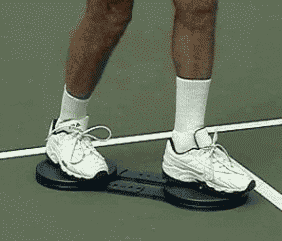
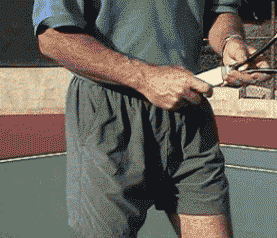
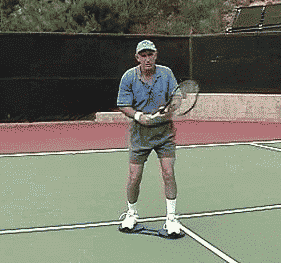
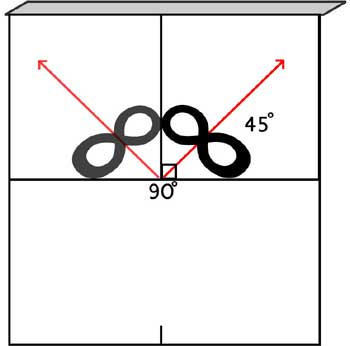
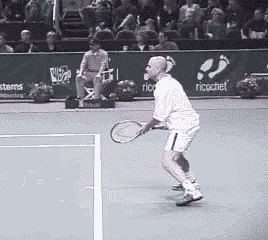
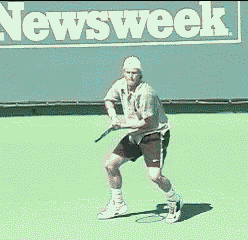
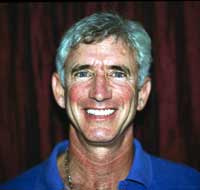 Jack Broudy was born and raised in Stamford, Connecticut and although he was active in many other sports activities, decided at age 14 he would pursue tennis as a career. He played in National Junior tours, the NCAAs, won many titles as a kid and went on to play winning tennis though his college years both at the University of North Carolina at Chapel Hill and UC San Diego.>
Jack Broudy was born and raised in Stamford, Connecticut and although he was active in many other sports activities, decided at age 14 he would pursue tennis as a career. He played in National Junior tours, the NCAAs, won many titles as a kid and went on to play winning tennis though his college years both at the University of North Carolina at Chapel Hill and UC San Diego.>